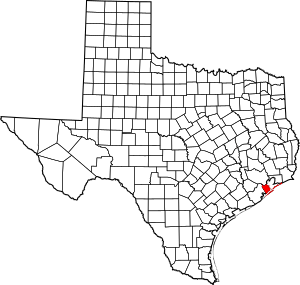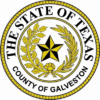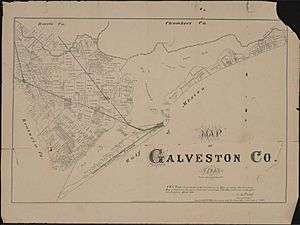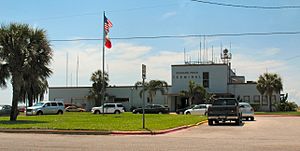Galveston County, Texas facts for kids
Quick facts for kids
Galveston County
|
||
|---|---|---|

Galveston County Courts Building
|
||
|
||

Location within the U.S. state of Texas
|
||
 Texas's location within the U.S. |
||
| Country | ||
| State | ||
| Founded | 1838 | |
| Named for | City of Galveston | |
| Seat | Galveston | |
| Largest city | League City | |
| Area | ||
| • Total | 874 sq mi (2,260 km2) | |
| • Land | 378 sq mi (980 km2) | |
| • Water | 495 sq mi (1,280 km2) 57% | |
| Population
(2020)
|
||
| • Total | 350,682 | |
| • Estimate
(2021)
|
355,062 |
|
| • Density | 401.24/sq mi (154.92/km2) | |
| Time zone | UTC−6 (Central) | |
| • Summer (DST) | UTC−5 (CDT) | |
| Congressional district | 14th | |
Galveston County is a county in the U.S. state of Texas. It is located along the Gulf Coast, right next to Galveston Bay. In 2020, about 350,682 people lived here.
The county was started in 1838. Its main government center, called the county seat, is the City of Galveston. This city was founded a year later on Galveston Island. The biggest city in the county is League City. It's a suburb of Houston and grew larger than Galveston in the early 2000s. Galveston County is part of the larger Greater Houston area, which includes nine counties.
Contents
History
One of the first big settlements in Galveston County was a town called Campeche. It was on Galveston Island and was created by the famous pirate Jean Lafitte. Lafitte built a busy "pirate kingdom" around Galveston Bay. But the United States Navy eventually made him leave the area. Later, the area became part of Mexico, and Galveston became an important port during the Texas Revolution.
Galveston County was officially formed on May 15, 1838, when Texas was its own country, the Republic of Texas. The county was made from parts of other counties. Galveston Island and its city were the most important places. The city of Galveston was the biggest city in the Republic of Texas. It was a center for business and culture. Port Bolivar was another important port. At first, most of the land was used for ranching and small farms.
When Texas joined the United States, Galveston continued to grow. It became a major center for trading cotton around the world. As railroads were built in the 1800s, small towns grew along the tracks. But Galveston remained the most important city. Near the end of the 1800s, some investors started Texas City. They hoped it would become a port city that could compete with Galveston. This new port opened just before the 1900s.
The 1900 Galveston hurricane was a terrible storm that hit the county. It killed about 6,000 people on Galveston Island alone. Many others died in other parts of the county. The Port of Galveston had to close for a while to rebuild. However, the Port of Texas City was able to open again almost right away. This showed how useful the new port city was.
People had always worried that the Texas coast was dangerous for big businesses because of hurricanes. The 1900 storm seemed to prove them right. Even though Galveston quickly rebuilt its port, many big investments moved inland, mostly to Houston. Soon, Houston and Texas City became bigger ports than Galveston.
The oil boom in Texas started in 1901. Soon, oil pipelines and refineries were built in Texas City. Industries grew a lot, especially during World War II. Galveston's factories, however, did not grow as much during the 1900s.
Galveston had always been a popular place for tourism, even before the storm. It became a well-known tourist spot across the country. Entertainment businesses spread throughout the county. There were even big casino areas in Kemah and Dickinson. This was because law enforcement in the county was not very strict about gambling. People from Houston sometimes joked about the Galveston County line being the "Maceo-Dickinson line." The county did well as oil helped Texas City's industries grow. Rich tourists also came to Galveston and other fun areas.
In the 1950s, the gambling businesses were finally shut down by state law enforcement. Galveston's economy suffered a lot. Some other towns in the county that relied on tourism also struggled. Texas City's economy was strong because of its industries, so it was not affected as much.
In 1963, NASA's Johnson Space Center was built nearby. This brought new growth to the towns in Galveston County near Clear Lake and Harris County. These Clear Lake communities in both Harris and Galveston Counties became more connected. Meanwhile, Galveston Island struggled for many years as businesses moved to the mainland.
Today, tourism has grown again in the county, both on the island and the mainland. It is now a major industry. Aerospace and related service jobs are still important in the Clear Lake area. Texas City has also become a major center for making chemicals from oil.
Geography
Galveston County is located on the flat lands of the Texas Gulf Coast. It is in the southeastern part of the state. The county is bordered on the northeast by Galveston Bay. To the northwest, it is bordered by Clear Creek and Clear Lake. A large part of the county covers Galveston Bay. To the south, it is bordered by the Gulf of Mexico with its beaches and the Galveston Seawall.
According to the U.S. Census Bureau, the county covers 874 square miles (2,264 km²). About 378 square miles (979 km²) is land, and 495 square miles (1,282 km²) is water. This means 57% of the county's area is water!
Adjacent counties
- Harris County (north)
- Chambers County (northeast)
- Brazoria County (west)
Communities
Galveston County has several areas that are not part of any city. Most of these are on the Bolivar Peninsula. Other areas are outside of Hitchcock and Santa Fe along Texas State Highway 6. There are also three communities in the "Bayshore" area: Bacliff, San Leon, and Bayview.
Cities
- Bayou Vista
- Clear Lake Shores
- Dickinson
- Friendswood (partly in Harris County)
- Galveston (county seat)
- Hitchcock
- Jamaica Beach
- Kemah
- La Marque
- League City (partly in Harris County)
- Santa Fe
- Texas City
Villages
Census-designated places
Unincorporated communities
Alta Loma, which used to be an unincorporated area, became part of Santa Fe in 1978.
Demographics
| Historical population | |||
|---|---|---|---|
| Census | Pop. | %± | |
| 1850 | 4,529 | — | |
| 1860 | 8,229 | 81.7% | |
| 1870 | 15,290 | 85.8% | |
| 1880 | 24,121 | 57.8% | |
| 1890 | 31,476 | 30.5% | |
| 1900 | 44,116 | 40.2% | |
| 1910 | 44,479 | 0.8% | |
| 1920 | 53,150 | 19.5% | |
| 1930 | 64,401 | 21.2% | |
| 1940 | 81,173 | 26.0% | |
| 1950 | 113,066 | 39.3% | |
| 1960 | 140,364 | 24.1% | |
| 1970 | 169,812 | 21.0% | |
| 1980 | 195,940 | 15.4% | |
| 1990 | 217,399 | 11.0% | |
| 2000 | 250,158 | 15.1% | |
| 2010 | 291,309 | 16.5% | |
| 2020 | 350,682 | 20.4% | |
| 2023 (est.) | 361,744 | 24.2% | |
| U.S. Decennial Census 1850–2010 2010 2020 |
|||
In 2000, Galveston County had 250,158 people. By the 2020 census, the population had grown to 350,682. The county is home to a diverse mix of people. In 2020, about 54.57% of residents were non-Hispanic white, 12.30% were non-Hispanic Black or African American, and 25.28% were Hispanic or Latino (of any race).
In 2000, about 33.80% of households had children under 18 living with them. The average household had 2.60 people. The median age in the county was 36 years old.
Education
Eight different school districts serve the communities in Galveston County:
- Clear Creek ISD
- Dickinson ISD
- Friendswood ISD
- Galveston ISD
- High Island ISD
- Hitchcock ISD
- Santa Fe ISD
- Texas City ISD
A ninth school district, La Marque Independent School District, joined Texas City ISD in 2016. This happened after the Texas Education Agency removed its accreditation because of poor school performance and money problems.
Higher education
The city of Galveston has two colleges. One is Texas A&M University at Galveston, which is part of the main A&M campus in College Station. The other is the University of Texas Medical Branch at Galveston.
The state of Texas has also said that two community colleges serve the area. College of the Mainland helps students from Texas City, Hitchcock, Santa Fe, Friendswood, Dickinson, and the Clear Creek ISD area in Galveston County. Galveston College serves students from Galveston ISD and High Island ISD.
Public libraries
The Galveston County Library System runs libraries in most of the bigger towns and cities. The Rosenberg Library in Galveston is the oldest public library in Texas. It is also the main office for the Galveston County Library System. Its librarian is also the Galveston County librarian. There are seven other libraries in Galveston County. These include the Genevieve Miller Library in Hitchcock, the La Marque Public Library, the Helen Hall Public Library in League City, the Moore Memorial Public Library in Texas City, the Dickinson Public Library, the Friendswood Public Library, and the Mae Bruce Library in Santa Fe.
Hospital services
Galveston County has a large medical center in Galveston and a private hospital in Texas City.
The University of Texas Medical Branch in Galveston is a big medical center with 1,200 beds and seven hospitals. The main hospital is John Sealy Hospital. Other hospitals on campus specialize in care for women, children, burn victims, older people, and mental health. UTMB is a top-level trauma center. This means it is the main hospital for serious injuries in the nine-county area of southeast Texas, including the Greater Houston area.
The Mainland Medical Center is a private hospital in Texas City. It has 233 beds.
Transportation
Major highways
 Interstate 45
Interstate 45 State Highway 3
State Highway 3 State Highway 6
State Highway 6 State Highway 87
State Highway 87 State Highway 96
State Highway 96 State Highway 124
State Highway 124 State Highway 146
State Highway 146 State Highway 275
State Highway 275
Airports
Scholes International Airport at Galveston is the only public airport in the county. It is on Galveston Island and has two runways. It is mainly used for private planes, flights for offshore energy companies, and some military operations.
There are also private airports for private use. These include Creasy Airport and Kami-Kazi Airport, both in areas not part of any city.
The closest airport with regular passenger flights is William P. Hobby Airport in Houston. The Houston Airport System also says that Galveston County is served by George Bush Intercontinental Airport. This is a large international airport near Houston in Harris County.
Private heliports (for helicopters) for private use include:
- The University of Texas Medical Branch in Galveston has two heliports.
- Republic Helicopters Heliport is in an unincorporated area near Hitchcock.
Rail
All train traffic in Galveston County is currently for industries. Regular passenger train service stopped on April 11, 1967.
Mass transit
The City of Galveston has a public transportation system called Island Transit.
Notable people
- John Baptista Ashe, a former U.S. Representative for Tennessee.
- Dez Bryant, an American football wide receiver for the Dallas Cowboys, was born in Galveston County.
- Red Bryant, an American football defensive end for the Seattle Seahawks, was born in Galveston County.
- YBN Almighty Jay, a rapper in the YBN collective, was born in Galveston County.
- Larry Taylor, a Republican member of the Texas Senate from District 11 (2013–present) and the Texas House of Representatives from District 24 (2003–2013).
See also
 In Spanish: Condado de Galveston para niños
In Spanish: Condado de Galveston para niños




